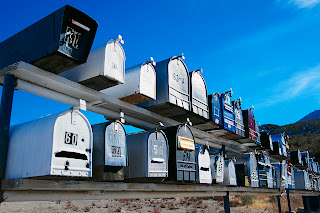
I'm preparing a direct mail campaign for my new business. I've run many campaigns in the past and I think they're great fun.
Part scavenger hunt, part fishing expedition, and part gamble, they require resourcefulness and creativity to design, as well as skill to manage the details and deadlines of production.
The Direct Mail Stigma
"Direct mail" is usually associated with junk mail. And, yes, it's true, that the people to whom you are sending mail are not inviting you to solicit them. But that doesn't mean that they won't be happy to hear your message! You're in business to provide a valuable service or solve some kind of problem, aren't you? With a helpful and friendly message, your unsolicited mail will provide at least one recipient with an answer to a dilemma. Don't avoid direct mail because of the stigma attached to the phrase.
Types of Direct Mail Campaigns
There are two types of direct mail campaigns ~ acquisition campaigns and conversion campaigns. In other words, you either want to acquire new customers, or you are mailing to current customers in hopes of coverting them to better customers.
Acquisition campaigns generally have a very low rate of return, at or below 1%. If you're mailing to only 500 people who have never heard of your business before, don't be surprised if only 3 people respond.
I usually budget for a .5% return so I can be sure that my mailing, even with poor results, will still break even. In other words, if I know I want to get 25-50 customers, I plan on sending out 6,000 pieces. I pay attention to every line item of cost associated with that mailing so I know that even at the lowest end of expected response, I'll recoup my money.
With conversion mailings, you can achieve great results. Your rate of return from a mailing to hot prospects can be very high, above 30%. The success of this type of campaign depends on how conditioned your prospects are to responding to your offers, what type of products or services you offer (e.g., a consumable vs. meeting a one-time time), how compelling your message is, and the timing of your campaign.
The Mailing List
In an acquisition mailing, you rent a mailing list for a one time use and send out a direct mail piece to the people on that list with the hope of inspiring them to become your customers.
Finding the right list to use is what feels a bit like a scavenger hunt. For general regional or national audiences, you would likely use a mailing list service like InfoUSA. You can work with this kind of list service company to target specific types of households by income, zip code ~ even by magazine subscription.
If you have a very specific type of audience in mind, you might look to rent a private organization's mailing list, such as a membership list from a professional association. Or, you might look to public records or notices, like the type that are published in business journals.
The Call to Action
Because you're mailing to a list that doesn't belong to you, your piece has to spur recipients to give you their information. This when a direct mail campaign feels like fishing. You cast your net knowing that most of the fish are going to get away, and hoping to capture just a few.
To make people respond to your mailing, you have to be able to get them in touch with you. This can be as direct as asking them to call you, or as back-door as asking them to enter a contest in which you collect their personal information for later sales follow up.
This part is referred to as "the call to action." It's the critical element in determining the success of your mailing. Calls to action have to be timely ("act now" or "limited time offer"), specific ("call now" or "enter today") and compelling ("receive a free gift" or "risk-free trial").
Designing Your Mail Piece
You greatly increase your rate of return and the success of your acquisition or conversion mailing by having it professionally prepared.
Many small business owners with great sales instincts can write a good call to action and believe it will stand out on its own without great design and production. They have an office assistant write the mailing and put it together using clip art, Microsoft Word and a desk jet printer.
Don't do that!
The postage and mailing list costs are going to be the biggest expenses of your mailing; don't waste that money by skimping on the design!
Digital printing services are so inexpensive that they're a cost-effective way to get a professionally printed piece. There are even digital printers who can be a one-stop shop, offering list rental and mailing services (check out ModernPostcard.com).
And there's just no substitute for great graphic design. Pay a professional designer to integrate your logo and call to action into a compelling visual piece. You'll probably double your rate of return with that investment and you can find great designers who can do your piece for less than $200.
If your mailing is more complicated than a small postcard (oversized postcard, invitation, letter), you should also hire a professional copywriter to craft the message for you. While a great visual design will grab recipients' attention, great writing will spur them to act. For an amount as small as $75 to $150, it's worth using an expert who can help increase your rate of return.
Let the Money Roll In
Now you get to sit back and wait for the results. If you were clear about the goals of your mailing, made your call to action timely and specific, you were realistic with projecting your rate of return, you should find direct mail a rewarding and effective way to grow your business.








No comments:
Post a Comment